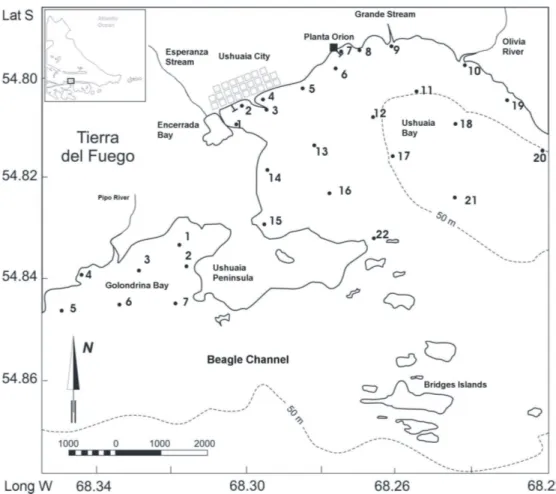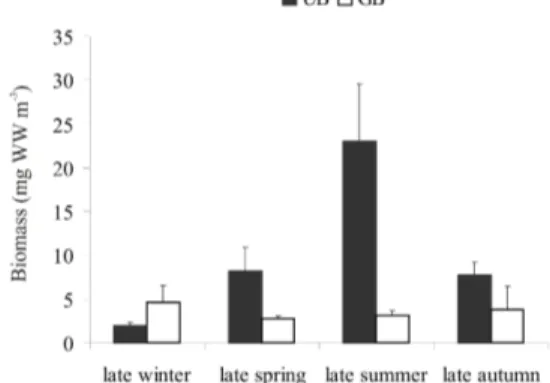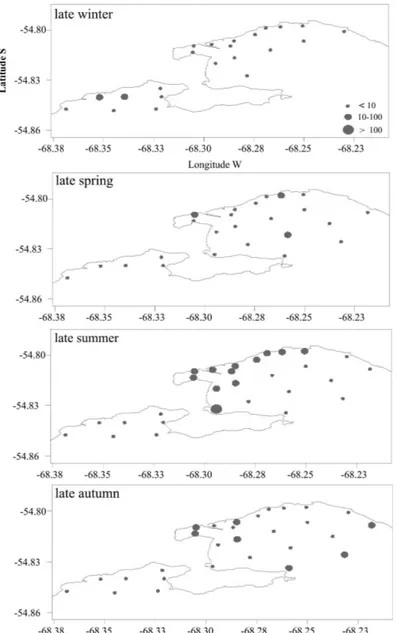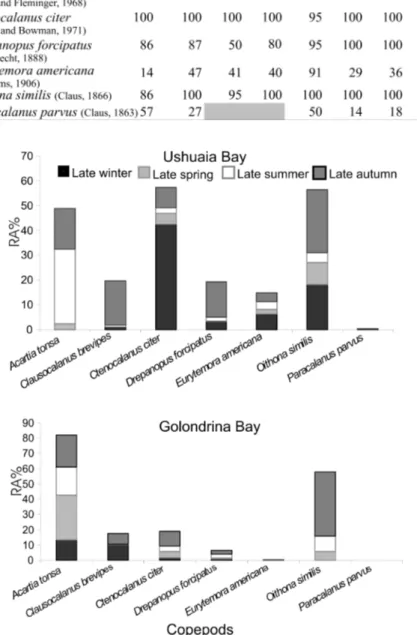SEASONAL AND SPATIAL VARIATION OF MESOZOOPLANKTON BIOMASS IN
USHUAIA AND GOLONDRINA BAYS (BEAGLE CHANNEL, ARGENTINA)
Florencia Biancalana*, Soledad L. Diodato and Mònica S. Hoffmeyer
Instituto Argentino de Oceanografía (IADO-CONICET)
(Camino La Carrindanga Km 7,5, C.C. 804, B8000FWB, Bahía Blanca, Argentina)
*Correspondência: biancaf@criba.edu.ar
Descriptors: Biomass, Mesozooplankton, Beagle Channel. Descritores: Biomassa, Mesozooplâncton, Canal Beagle.
Mesozooplankton constitutes the most important food source for larval and planktivorous fish and also plays a key role as an energetic link between primary producers and secondary consumers (KIØRBOE, 1991; NEUMANN-LEITAO et al., 1999). Also, mesozooplankton supports the marine ecosystem functioning by controlling primary production and, hence, the transfer of carbon through the pelagic food web (ESCRIBANO et al., 2007). Thus, estimation of mesozooplankton biomass and density is relevant from both fisheries and biological oceanography viewpoints. Studies on the seasonal variation of zooplankton biomass as a potential measurement of food sources for fish species have been carried out in the southern Patagonian shelf (45º to 55ºS)(SABATINI; ÁLVAREZ COLOMBO, 2001; SABATINI et al., 2001). Also, the role of environmental forcing in determining seasonal and spatial zooplankton biomass distribution has been investigated in the same region (SABATINI et al., 2004). The zooplankton composition and dynamic in the Magellan region including the Beagle Channel have been well studied (GUGLIELMO; IANORA, 1995, 1997; MAZZOCCHI; IANORA, 1991; ANTEZANA, 1999; DEFREN-JANSON et al., 1999; LOVRICH, 1999). In addition, several studies on quality and quantity of mesozooplankton community have been carried out so far in the Beagle Channel (FERNANDEZ-SEVERINI; HORFFMEYER, 2005; BIANCALANA et al., 2007) but the variation of mesozooplankton biomass has not been deeply addressed until now.
This study is therefore the first attempt to evaluate the mesozooplankton biomass variation in Ushuaia and Golondrina Bays in the Beagle Channel. The main objective was to analyze the seasonal and spatial variation of mesozooplankton biomass in these bays taking into account some environmental factors that could be modulating its dynamics.
Fig. 1. Map of the study area and the location of the sampling stations in Ushuaia and Golondrina bays, Beagle Channel.
Sampling was carried out seasonally in late winter (26-27 Aug 2004); late spring (09 Dec 2004), late summer (02-04 Mar 2005) and late autumn (14-15 Jun 2005). Samples were obtained from 22 and 7 stations located in UB and GB, respectively. Mesozooplankton samples were collected using plankton net with a 0.30 m mouth diameter and 200
µm mesh size, by means of oblique hauls from close to the bottom, up to the surface, aboard a motor boat at a speed of 2 knots during 5 minutes. A General Oceanics® digital flowmeter was used to estimate the seawater volume filtered. The volume of seawater filtered ranged from13.65 to 19.64 m3 in UB and from 15.66 to 19.15 m3 in GB. Samples were preserved in
4% formalin (BOLTOVSKOY, 1981).
Mesozooplankton biomass was estimated by the gravimetric method in terms of wet weight and expressed in mg WW m-3 (POSTEL et al., 2000). The samples were vacuum-filtered using a nylon filter (30 µm pore) in order to remove the interstitial water and then were directly weighed in a S¢IENTESH SA210 analytic balance (BOLTOVSKOY, 1981). Qualitative and quantitative analysis were done under Wild M5
stereoscopic microscope according to reference (BOLTOVSKOY, 1981; GUGLIELMO; IANORA, 1995, 1997). Surface salinity and temperature conditions were registered at each sampling date using a multiparametric probe (HORIBA U-10). Surface water samples were also obtained by Van Dorn bottle for Chlorophyll a determination (STRICKLAND;
PARSONS, 1972). Non-parametric statistical procedures were used since the results of the present study did not meet the assumptions of normality and equality of variance (SOKAL; ROHLF, 1979). Mann-Whitney U-test was applied to detect differences in mean biomass values between bays and Kruskal-Wallis test was used to find differences among seasons. In cases where significant differences among seasons were found, Mann-Whitney U-test with Bonferronis correction was applied. All statistical analyses were conducted at a significance level of 0.05 (SOKAL; ROHLF, 1979). Surfer 8 software was used to plot mesozooplankton biomass in order to assess its spatial distribution.
UB, and from 2.71 (late spring) to 4.63 mg WW m-3 (late winter) in GB (Fig. 2). In UB significant differences of mean biomass were detected among seasons (p<0.01), except between late spring and late summer, while in GB no significant differences were found (Fig. 2). In accordance with our results, higher values of zooplankton biomass during spring-summer were found in a study conducted along the southern Patagonia shelf between 50º S to 55º S latitude (SABATINI; ÀLVAREZ COLOMBO, 2001). In addition, these authors estimated that 60-80 % of zooplankton biomass was made up of copepods in the whole southern Patagonian shelf region coinciding with our results.
Fig. 2. Seasonal variation of mesozooplankton biomass (mg WW m-3) in Ushuaia and Golondrina bays. Mean ± SE (=
SD/ sq. root (n)).
In UB, the mesozooplankton biomass values ranged from 0.63 mg WW m-3 (station 2, late winter) to 129.46 mg WW m-3 (station 15, late summer) (Fig. 3). These biomass values were notably lower than
those reported by SABATINI; ÀLVAREZ
COLOMBO (2001), which found that zooplankton biomass (<5 mm size fraction) ranged from 100 to 1000 mg WW m-3 in spring. This difference in biomass could be due to the influence of marine currents, local wind forces, the propagation of tidal waves, freshwater discharges, among others factors (SABATINI et al., 2004). These authors mentioned that the highly energetic flow of the Antarctic Circumpolar Current produce largest variances in temperature and salinity in the southern region between Tierra del Fuego and Isla de los Estados (SABATINI et al., 2004). Particularly in UB, a permanent and strong current which enters from the Beagle Channel (BALESTRINI et al., 1990) and freshwater inputs (Olivia River and Grande Stream) joined with wastewater discharges (GIL et al., 2011), could produce variability in temperature and salinity as well as changes in phytoplankton and mesozooplankton dynamics. Also, SABATINI et al. (2004) suggested that the permanent mixture of the
water column causes that algal cells to receive limited amount of light because of their continuously up and down movements. Consequently, the phytoplankton production could be very low (SABATINI et al., 2004). In addition, HERNANDO; SAN ROMÀN (1999) suggested that enhanced levels of UVB related to the thinning of the ozone layer, could explain the lower phytoplankton production in the Beagle Channel. Thus phytoplankton biomass and production could be lower in the study area than in other environments of low latitudes. This fact may have a direct consequence on the biomass of herbivorous zooplankters in these areas.
The chlorophyll a values ranged from
0.31(late autumn) to 11.13 mg m-3 (late summer) in UB and from 0.27 (late autumn) to 2.73 mg m-3 (late spring) in GB (Fig. 4). The observed increase in chlorophyll a values in both bays during late
spring-summer reflect a greater phytoplankton activity favored by an increase in temperature, optimal light condition, and high concentration of nutrients, especially near the coast in both bays (FERNANDEZ-SEVERINI; HOFFMEYER, 2005; BIANCALANA; TORRES, 2011; GIL et al., 2011). The highest mesozooplankton biomass observed in UB during late summer, apparently follows the annual phytoplankton
maximum (FERNANDEZ-SEVERINI;
HOFFMEYER, 2005). However, temporal variation of the mesozooplankton biomass could be explained not only by the phytoplankton availability (bottom up mechanisms) but also by predation, which must be taken into account as a top down control. Low grazing pressure of herbivores as a consequence of predation on them by planktonic carnivores as Themisto gaudichaudii, would also contribute to the
phytoplankton production. In addition, increases in mesozooplankton biomass from late spring to late summer in UB, were associated not only with temperature and chlorophyll a rise, but also with
salinity decrease (Fig. 4). Low salinities during warm seasons in both bays are direct consequences of freshwater inputs from several defrost fluxes such as streams, rivers and runoff (TORRES et al., 2009; AMIN et al., 2011b; GIL et al., 2011). Concerning mesozooplankton biomass in GB, the lowest (0.44 mg WW m-3) and the highest (12.71 mg WW m-3) values were recorded in late winter at stations 6 and 4, respectively (Fig. 3). The increase in mesozooplankton biomass during late winter was given by maximum abundances registered of Halicarcinus plantanus
values in this period reflected phytoplankton biomass. Consequently, the mesozooplankton food sources were more significant in UB than in GB. Finally, these conditions would produce a subsequent increase in the mesozooplankton abundance which could be reflected in the biomass values. Concerning the spatial distribution of mesozooplankton biomass in the four seasons, it was observed that it showed a definite pattern. The highest values were registered mainly close to the northwestern coast of both bays, being this pattern stronger in UB in late summer (Fig. 3). This fact could be a quick response of mesozooplankton (in
number and mass terms) to the phytoplankton biomass available, favored by higher nutrient concentrations in the coastal zone. The presence of dense macroalgae beds, in which Macrocystis pyrifera is the dominant
species, is associated with nutrient recycling, probably contributing to the extraction of nutrients from water column, and supporting an important bentho-pelagic coupling (ADAMI; GORDILLO, 1999; TORRES et al., 2009). Interestingly, this shallow zone is the most affected area by organic and nutrient loadings (AMIN et al., 2011b; GIL et al., 2010; TORRES et al., 2009).
Fig. 4. Mean Chlorophyll a, temperature and salinity seasonal variation in Ushuaia and Golondrina bays. Mean ± SE (= SD/ sq. root (n)); T: Temperature, S: Salinity, C: Chlorophyll a, UB: Ushuaia Bay, GB: Golondrina Bay.
The most important copepods, which contributed to the total mesozooplankton biomass values, are shown on Table 1. Ctenocalanus citer, Clausocalanus brevipes and Drepanopus forcipatus
were the most dominant copepods in late winter-autumn in both bays (Fig. 5). Those are typical species of Sub-Antarctic areas (DEFREN-JANSON et al., 1999) and have already been mentioned for Ushuaia and Golondrina bays in winter by BIANCALANA et al, 2007. These species were usually found with high abundance in stations close to the Beagle Channel. In late spring-summer, cosmopolitan small-sized copepods like Acatia tonsa and Oithona similis, were dominant contributing to the biomass in both bays.
Paracalanus parvus and Eurytemora americana were became important in late autumn and late spring-summer, respectively (Fig. 5). These species were observed mostly in coastal stations. Eurytemora americana was particularly associated with a coastal zone in UB with a certain degree of eutrophication (station 1 and 2) (BIANCALANA; TORRES, 2011). Fernandez-Severini and Hoffmeyer (2005) reported the presence of these species in summer for Ushuaia and Golondrina bays. These authors mentioned that calanoid copepods were the dominant species within mesozooplankton followed by the cyclopoid copepod
O. similis (FERNANDEZ-SEVERINI;
HOFFMEYER, 2005). All these species mentioned above, have also been reported by Guglielmo and Ianora (1995) and Mazzocchi and Ianora (1999) for the Magellan region. Other groups such as Cladocera,
Amphipoda, Euphausiacea, Mysidacea and
Appendicularia, which have been registered in the Magellan region (DEFREN-JANSON et al., 1999; GUGLIELMO; IANORA, 1997), were also observed in the samples collected for the present study. The presence in UB and GB of the above mentioned species is particularly relevant from a trophic point of view because these organisms constitute the most important food source for zooplanktivorous fishes and
fish larvae in the Beagle Channel (SABATINI; ÀLVAREZ COLOMBO, 2001; SABATINI et al., 2001). In addition, different stages of relative small copepods like C. brevipes, D. forcipatus and O. similis
present in spring are considered to be the adequate food items for larvae and post-larvae of Patagonian sprat Sprattus fuegensis being the Beagle Channel and
Fueguian Channels its spawning area (ARANIS et al., 2007; SANCHEZ et al., 1995; SABATINI et al., 2001). Zooplankton assemblages found in our study are also the main food source for this fish species and for other zooplanktonic fishspecies like Odontesthes nigricans and the genus Patagonotothen spp. (Fam. Notothenidae) which are also commonly registered in the Fueguian subdistrict (South Patagonian District) (LÒPEZ et al., 1996; BALECH; EHRLICH, 2008). Adults of some small-sized species like O. similis, P. parvus, A. tonsa, E. americana as well as the first
development stages of these copepods and D. forcipatus probably were not properly sampled with
the net used in this study, due to the pore size (200 µm) (DI MAURO et al., 2009; ANTACLI et al., 2010). However, we assume that they were available as prey and their biomass values followed the general trends found for adults which were effectively retained by the net. According to our findings, most of coastal mesozooplankton assemblages are composed by these small-sized copepods which generally dominate in abundance and biomass terms (TURNER, 2004).
Consequently, this process indirectly contributes to modulate the spatial-seasonal distribution patterns of mesozooplankton. The wind seems to be another control factor. Contrary to what was observed in UB,
GB was influenced by winds belong to S-SW and N-NE and these ones seems to play an important role on forcing circulation and consequently in the distribution of plankton biomass.
Table 1. Frequency of occurrence (FO %) of the most important copepod species found in Ushuaia Bay in all sampling periods.
To summarize, differences in physical and hydrological features as well as the availability of phytoplankton biomass are some of the factors that could influence mesozooplankton biomass distribution in Ushuaia and Golondrina Bays. Others factors that could affect the mesozooplankton biomass distribution are: the action of winds, different depths and water circulation (BALESTRINI et al., 1990), seasonal and spatial variations of mesozooplankton abundance and
composition (FERNANDEZ-SEVERINI;
HOFFMEYER, 2005; BIANCALANA et al., 2007), phytoplankton biomass (BIANCALANA et al. 2007), seasonal conditions of temperature, salinity and nutrients (GIL et al., 2011), anthropogenic influence in the coastal area (TORRES et al., 2009; AMIN et al., 2011b; DUARTE et al., 2011; GIL et al., 2011), distribution of the Macrocystis forests (ADAMI;
GORDILLO, 1999). The results obtained in this study demonstrate that mesozooplankton biomass displays a different spatial and seasonal pattern in both bays. Finally, this research not only puts emphasis on the mesozooplankton biomass dynamic in both bays but also highlights the presence of copepods that can play a key role in the pelagic-food web of the study area.
A
CKNOWLEDGEMENTSFunds were provided by FONCYT-ANPCyT (PICTR090/2002). We are grateful to i) the staff of the Centro Austral de Investigaciones Científicas (CONICET), ii) the staff of the Centro Nacional Patagònico (CENPAT-CONICET) especially to Dr. M. N. Gil and Dr. J. L Esteves, and iii) to Dr. Erika Giarratano and Dr. Amèrico I. Torres, for their collaboration and support during the sampling period. We are also grateful to Dr. Melisa Fernandez-Severini and Biól. Sofia Dutto for their help in the English correction.
R
EFERENCESADAMI, M. L.; GORDILLO, S. Structure and dynamics of the biota associated with Macrocystis pyrifera (Phaephyta) from the Beagle Channel, Tierra del Fuego. Sci. Mar., v. 63, n. 1, p. 183-191, 1999.
AMIN, O.; COMOGLIO, L.; SERICANO, J. Polynuclear aromatic and chlorinated hydrocarbons in mussels from the coastal zone of Ushuaia, Tierra del Fuego, Argentina. Environ. Toxicol. Chem. v. 30, n 3, p 521-529. 2011a. AMIN, O.; COMOGLIO, L.; SPETTER, C.; DUARTE, C.;
ASTESUAIN, R.; FREIJE, R. H.; MARCOVECCHIO, J. Assessment of land influence on a high latitude marine coastal system: Tierra del Fuego, southernmost Argentina. Environ. Monit. Assess., v. 175, n. 1-4, p. 63-73, 2011b.
ANTACLI, J. C.; HERNÀNDEZ, D.; SABATINI, M. E. Estimating copepods abundance with paired nets: Implications of mesh size for population studies. J. Sea Res., v. 63, p. 71-77, 2010.
ANTEZANA, T. Hydrographic features of Magellan and Fuegian inland passages and adjacent Subantarctic waters. Sci. Mar., v. 63, n. 1, p. 23-34, 1999.
ARANIS, A. R.; MELÈNDEZ, R. C.; PEQUEÑO, G. R.; CERNA, F. T. Sprattus fuegensis in the inland waters of Chiloe, Chile (Osteichthyes: Clupeiformes: Clupeidae). Gayana, v. 71, n.1, p. 102-113, 2007.
BALECH, E.; EHRLICH, M. D. Esquema biogeogràfico del Mar Argentino. Rev. Invest. Desarr. Pesq., v. 19, p. 45-75, 2008.
BALESTRINI, C.; MANZELLA, G.; LOVRICH, G. A. Simulación de corrientes en el Canal Beagle y Bahía Ushuaia, mediante un modelo bidimensional. Servicio de Hidrografía Naval, Technical Report n. 98, 58 p., 1990.
BIANCALANA, F; TORRES, A. I. Variations of mesozooplankton composition in a eutrophicated semi-enclosed system (Encerrada Bay, Tierra del Fuego, Argentina). Braz. J. Oceanogr., v. 59, n. 2, p. 195-199, 2011.
BIANCALANA, F; BARRÌA DE CAO, M. S.; HOFFMEYER, M. S. Micro and mesozooplankton composition during winter in Ushuaia and Golondrina bays (Beagle Channel, Argentina). Braz. J. Oceangr., v. 55, n. 2, p. 83-95, 2007.
BOLTOVSKOY, D. Características biológicas del Atlántico Sudoccidental. In: BOLTOVSKOY, D. (Ed.). Atlas del zooplancton de Atlántico Sudoccidental y métodos de trabajo con el zooplancton marino. Mar del Plata: INIDEP, 1981. p. 239-248.
DEFREN-JANSON, K.; SCHNACK-SCHIEL, S. B.; RICHTER, C. Mesozooplankton communities in the Magellan region. Sci. Mar., v. 63, n. 1, p. 43-50, 1999. DI MAURO, R.; CAPITANIO, F.; VIÑAS, M. D. Capture
efficiency for small dominant mesozooplankters (Copepoda, Appendicularia) off Buenos Aires Province (34ºS-41ºS), Argentina sea, using two plankton mesh sizes. Braz. J. Oceanogr., v. 57, n. 3, p. 205-214. 2009.
DUARTE, C; GIARRATANO, E; AMIN, O; COMOGLIO, L. Heavy metal concentrations and biomarkers of oxidative stress in native mussels (Mytilus edulis chilensis) from Beagle Channel coast (Tierra del Fuego, Argentina). Mar. Pollut. Bull., v. 62, n. 8, p. 1895-1904, 2011.
ESCRIBANO, R.; HIDALGO, P.; GONZÁLEZ, H.; GIESECKE, R.; RIQUELME-BUGUEÑO, R.; MANRÍQUEZ, K. Seasonal and inter-annual variation of mesozooplankton in the coastal upwelling zone off central-southern Chile. Prog. Oceanog., v. 75, p.470-485, 2007.
FERNÁNDEZ-SEVERINI, M. D.; HOFFMEYER, M. S. Mesozooplankton assemblages in two different bays in the Beagle Channel (Argentina) during January, 2001. Sci. Mar., v. 69, n. 2, p. 27-37, 2005.
GIL, M.; TORRES, A. I.; AMÍN, O.; ESTEVES, J. L. Assessment of recent sediment influence in an urban polluted subantarctic coastal ecosystem. Beagle Channel (Southern Argentina). Mar. Pollut. Bull., v. 62, n. 1, p. 201-207, 2011.
GUGLIELMO, L.; IANORA, A. Atlas of marine zooplankton. Straits of Magellan. Copepods. Berlin: Springer-Verlag, 1995. 279 p.
HERNANDO, M. P.; SAN ROMÁN, N. Preliminary data on chronic effects of ultraviolet radiation on the growth of some phytoplankton species of the Beagle Channel, Argentina. Sci. Mar., v. 63, n. 1, p. 81-88, 1999. KIØRBOE, T. Pelagic fisheries and spatial-temporal
variability in zooplankton productivity. Bull. Plankton Soc. Japan, p. 229-249, 1991. (Special volume). LÓPEZ, H. L.; GARCÍA M. L.; SAN ROMÁN, N. A. Lista
comentada de la ictiofauna del Canal Beagle, Tierra del Fuego, Argentina. Contrib. cient., n. 23, 1996. 81p. LOVRICH, G. A. Seasonality of larvae of Brachyura and
Anomura (Crustacea Decapoda) in the Beagle Channel, Argentina. Sci. Mar., v. 63, n. 1, p. 347-354, 1999. MAZZOCCHI, M. G.; IANORA, A. A faunistic study of the
copepod assembleages in the Strain of Magellan. Boll. Oceanol. Teòr. Ed. Appl., v. 9, n. 2-3, p. 163-177, 1991.
NEUMANN-LEITÃO, S.; GUSMÃO, L. M.; SILVA, T.; NASCIMENTO-VIEIRA, D. A., SILVA, A. P. Mesozooplankton biomass and diversity in coastal and oceanic waters off North-Eastern Brazil. Arch. Fish. Mar. Res., v.47, n. 2-3, p. 153-165, 1999.
POSTEL, L.; FOCK, H.; HAGEN, W. Biomass and Abundance. In: HARRIS, R. P.; WIEBE, P. H.; LENZ, J.; SKJOLDAL, H. R.; HUNTLEY, M. (Ed.). ICES Zooplankton Methodology Manual. Academic Press, 2000. p.83-192.
SABATINI, M. E.; ÁLVAREZ COLOMBO, G. L. Seasonal pattern of zooplankton in the Argentina shelf off Southern Patagonia (45º -55ºS). Sci. Mar., v. 65, n. 1, p. 21-31, 2001.
SABATINI, M. E.; GIMÉNEZ, J.; ROCCO, V. Características del zooplancton del área costera de la plataforma patagónica austral (Argentina). Boln Inst. esp. Oceanogr., v.17, n. 3-4, p. 245-254, 2001. SABATINI, M.; RETA, R.; MATANO, R. Circulation and
zooplankton biomass distribution over the southern Patagonian shelf during late summer. Continent. Shelf Res., v. 24, p.1359-1373, 2004.
SANCHEZ, R. P.; REMESLO, A; MADIROLAS, A; CIECHOMSKI, J. D. Distribution and abundance of post-larvae and juveniles of the Patagonian sprat,
Sprattus fuegensis, and related hydrographic conditions.
Fish. Res., v. 23, p. 47-81, 1995.
SOKAL, R. R.; ROHLF; F. J. Biometría. Madrid: H. Blume, 1979. 832 p.
STRICKLAND, J. D. H.; PARSONS, T. R. A practical handbook of seawater analysis. Bull. Fish. Res. Bd Can., v. 167, 1972.
TORRES, A. I.; GIL, M. N.; AMÍN, O.; ESTEVES, J. L. Environmental Characterization of a eutrophicated semi-enclosed system: Nutrient budget (Encerrada Bay, Tierra del Fuego Island, Patagonia, Argentina). Water Air Soil Pollut., v. 204, p. 259-270, 2009.
TURNER, J. T. The importance of small planktonic copepods and their roles in pelagic marine food webs. Zool. Stud., v. 43, n. 2, p. 255-266, 2004.




